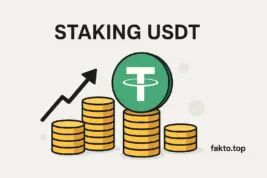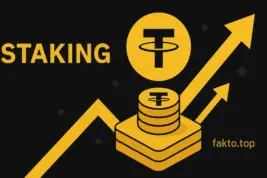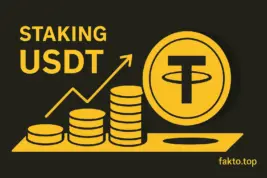USDT Staking Guide 2025: Earn Passive Crypto Income Without Trading Risk
Smart staking = solid gains
USDT Staking in 2025: Earn Crypto Yield Without Trading or Risking Your Bag
USDT staking is hands-down one of the easiest ways to earn passive crypto income without diving into charts or chasing pump-and-dumps. Thanks to Tether’s dollar peg and its massive adoption across platforms like Binance, Bybit, OKX, and Kraken, staking USDT has become the crypto version of a high-yield savings account — but with way better returns and zero bank drama.

For crypto newbies, it’s a chill entry point — no trading skills, no hardware, no stress. For seasoned holders, it’s a way to park stablecoins and let them work while you sleep. You choose the vibe: fixed terms or flexible access, low commitment or strategic allocation. With current APYs ranging from 3% to 12%, staking USDT lets you match your risk appetite with your goals. Platforms like Binance Earn have already become go-to hubs for stablecoin staking.
USDT staking is especially popular among users looking for low-risk crypto returns without market volatility. The key? Pick the right platform, check withdrawal rules, and stay aware of tax implications. Done right, staking USDT is like putting your dollars on autopilot — but with crypto flavor.
USDT Staking Explained — No Jargon, Just Gains
Staking USDT means locking your Tether tokens on a platform or exchange in exchange for yield. Unlike mining, it doesn’t require GPUs or tech wizardry. It’s basically crypto yield farming for normies — simple, stable, and scalable. Think of it as a digital deposit, but with better APY and no banker breathing down your neck.
USDT is a stablecoin pegged to the US dollar, meaning 1 USDT ≈ $1. That stability makes it perfect for staking, especially for beginners who want to earn without riding the crypto rollercoaster.
How USDT Staking Works — The Mechanism Behind the Magic
When you stake USDT, you’re lending it to the platform — whether it’s a centralized exchange or a DeFi protocol. They use your funds for lending, liquidity pools, or other yield-generating activities. In return, you earn interest, usually shown as Annual Percentage Yield (APY). Depending on the platform and terms, APY can range from 3% to 12%.

Fixed staking means locking your USDT for a set period — 7, 30, 90 days or more. You can’t touch it until the term ends, but the yield is usually higher. Flexible staking lets you withdraw anytime, but the APY is lower. Popular platforms include Binance Earn, OKX Earn, KuCoin, and DeFi giants like Aave and Compound.
Pros and Cons of USDT Staking
Pros:
- Low volatility thanks to USD peg
- Easy entry — no tech skills needed
- Available on most major exchanges
- Flexible or fixed terms to match your strategy
- Earn passive income in crypto without trading
Cons:
- Platform risk — exchanges can get hacked or freeze withdrawals
- Liquidity risk on DeFi platforms
- Regulatory uncertainty around Tether
- Potential asset freezes due to sanctions or investigations
Understanding the risks and choosing a reliable platform is key to successful USDT staking. Don’t just chase APY — chase sustainability.
Where to Stake USDT for Maximum Gains in 2025
- Binance Earn — fixed and flexible staking, up to 10% APY.
- OKX Earn — up to 8% yield, slick UI, strong security.
- Bybit — often runs promo campaigns for new stakers.
- KuCoin — supports both centralized and DeFi staking products.
- Aave & Compound — DeFi protocols using USDT for lending and liquidity pools.
Fact: In 2025, staking stablecoins like USDT isn’t just a side hustle — it’s a full-blown strategy. With the right platform and timing, you can turn idle dollars into yield-generating machines. Just remember: smart staking beats blind chasing. Always DYOR, and let your stablecoins stack while you sleep.
How to Choose the Right Platform for USDT Staking
APY numbers might look juicy, but don’t get baited by yield alone. Real crypto OGs know that platform reliability is just as important. Look for exchanges or protocols with solid track records, insurance coverage, security audits, and transparent terms. If a platform’s been hacked more times than you’ve changed your seed phrase — hard pass. Also check the minimum staking amount and lock-up periods. Some platforms let you dip in with 10 USDT, others want 100+. Flexibility matters, especially if you’re not ready to lock your bags for 90 days straight.
USDT Staking Yield Comparison — CeFi vs DeFi
| Platform | Type | Yield (APY) | Min Lock Period |
|---|---|---|---|
| Binance | Centralized | 3–10% | 7 days |
| OKX | Centralized | 4–8% | 7 days |
| Aave | Decentralized | 5–11% | No fixed term |
| Compound | Decentralized | 4–9% | No fixed term |
Why Investors Are Staking Tether (USDT)
USDT staking is blowing up because it hits the sweet spot: stable returns, low volatility, and high liquidity. As the most widely used stablecoin in crypto, USDT powers everything from DeFi lending to centralized exchange operations. That demand creates consistent yield opportunities — even when the market’s throwing tantrums.
In shaky market conditions, staking USDT lets you chill while your assets earn. No need to time the bottom or chase green candles. That’s why conservative investors and crypto rookies love it — it’s predictable, passive, and doesn’t require diamond hands.

USDT Staking FAQ — Real Answers for Real Degens
- Do I need a wallet to stake USDT? — Yep. You’ll need a crypto wallet compatible with your chosen platform. That could be a centralized exchange wallet (Binance, Kraken) or a DeFi-friendly one like MetaMask, Trust Wallet, Ledger, or Trezor. Hardware wallets = max security.
- Can I lose money staking USDT? — Sadly, yes. Risks include exchange hacks, smart contract bugs, rug pulls, or platform shutdowns. Stick to battle-tested platforms, use cold wallets, and diversify your staking bags.
- What’s the minimum amount to start staking? — Depends on the platform. CeFi exchanges might let you in with 10 USDT. DeFi protocols often require 50–100 USDT. Just don’t go too small — fees can eat your yield.
- Can I withdraw early? — If you’re in a flexible staking plan, yes — anytime, no penalty. Fixed staking? You’re locked in. Early withdrawal = lost yield or fees. Always read the fine print.
- Do I pay taxes on staking rewards? — Most likely. In many countries, staking income is taxable. Track your earnings, consult a tax pro, and don’t ghost the IRS. Crypto’s cool — tax evasion isn’t.
- Best platforms for USDT staking? — CeFi: Binance, Kraken, OKX. DeFi: Aave, Curve, Compound, PancakeSwap. CeFi = ease and support. DeFi = higher yield, higher risk.
- CeFi vs DeFi staking — which is better? — CeFi is beginner-friendly, insured, and simple. DeFi gives you full control and better APY, but you need wallet skills and risk tolerance. Choose your fighter.
- Which networks support USDT staking? — USDT runs on Ethereum (ERC-20), Tron (TRC-20), Binance Smart Chain (BEP-20), and more. Tron and BSC = low fees. Ethereum = high gas, but more DeFi options.
- How is staking income paid? — Usually daily or weekly. Some platforms auto-compound. Fixed staking = steady rate. Flexible = variable yield. Always check payout terms.
- Are there fees for staking USDT? — Yep. CeFi platforms may charge a small cut or flat fee. DeFi = gas fees, especially on Ethereum. Pick platforms with fair fee-to-yield ratio.
- What if the platform shuts down? — If it’s CeFi, you might be stuck. If it’s DeFi and you control your wallet, you’re safer. Always hold your keys, diversify, and stay updated on project news.
Bottom line: USDT staking is a legit way to earn passive crypto income — whether you’re a fresh-faced newbie or a battle-hardened degen. Just don’t go in blind. Choose your wallet, platform, and network wisely. Understand the risks, track your rewards, and stay flexible. The market moves fast — your strategy should too.
Fact: In crypto, stablecoins aren’t boring — they’re strategic. USDT staking turns idle dollars into yield machines. And in a world of volatility, sometimes the smartest move is staking the quiet coin that never crashes.
8 Crypto Facts About USDT Staking You Shouldn’t Ignore
- Stable ≠ Boring: USDT may not moon, but it quietly prints yield while the rest of the market goes full rollercoaster.
- CeFi vs DeFi = Safety vs Freedom: Centralized platforms offer insurance and support. DeFi gives you control and higher APY — but you’re on your own, anon.
- Gas Fees Matter: Ethereum staking can eat your profits if you’re not careful. Tron and BSC offer low-fee alternatives for stablecoin staking.
- Flexible ≠ Free: Flexible staking lets you withdraw anytime, but the yield is usually lower. Fixed staking locks your funds — and often pays better.
- Wallet = Your Fortress: Hardware wallets like Ledger and Trezor protect your staked USDT from hacks. Not your keys = not your coins.
- APY ≠ ROI: High APY looks sexy, but real returns depend on lock-up time, fees, and platform reliability. Always do the math.
- Regulators Are Watching: Tether’s legal status is still spicy. Stay updated on compliance news — especially if you’re staking big.
- Staking Is Strategy: Whether you’re farming yield or parking stablecoins during bear season, staking USDT is a legit move — if done smart.
Disclaimer / No Liability
We are not financial advisors and assume no responsibility for any decisions you make.Cryptocurrencies are highly volatile and risky. You may lose all invested capital.
Always do your own research (DYOR) and consult qualified professionals before making any financial or legal decisions.We make no guarantees regarding the accuracy, completeness, or reliability of the information provided.
References to third-party services or projects do not imply endorsement.By using this site, you agree that all actions are at your own risk and you release the site owners and authors from any liability.
